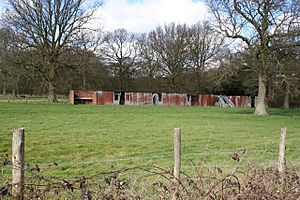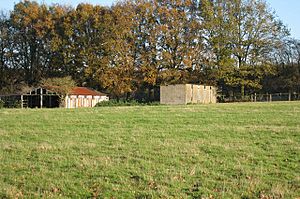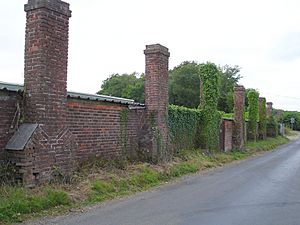Hopper hut facts for kids
A hopper hut was a simple, temporary home. It was built for people who picked hops on farms in England. This happened mostly in the 1800s and 1900s.
Contents
Why So Many Pickers?
Long ago, picking hops needed many workers. Farms did not have enough local people. So, whole families, including children, came from London. They left their homes to work in the hop fields of Kent, Sussex, Surrey, and Hampshire.
By the 1870s, special trains ran to take these hop pickers. They were called Hop Pickers' Specials. These trains carried Londoners to towns and villages at the start of the picking season. About 250,000 hop pickers from London went to Kent by the early 1900s. In other areas like Herefordshire and Worcestershire, workers came from the Black Country or South Wales.
At first, pickers lived in barns, stables, or even pigsties. They also used tents or slept in roof spaces. These places were often dirty. This caused health problems. For example, 43 hop-pickers died from cholera in 1849.
Making Things Better
In 1865, a man named Rev J Y Stratton started a campaign. He wanted to make living conditions better for hop pickers. Another person, Rev J J Kendon, was shocked by the poor conditions in Goudhurst. He also began to fight for improvements.
This led to a group being formed in 1866. It was called the Society for Employment and Improved Lodgings for Hop Pickers. New rules for picker housing began in Bromley in 1874. By 1889, Kendon had many helpers working to improve things.
In 1898, Father Richard Wilson, a priest from London, wondered where his church members went. He went with a family to the hop fields. He was also very upset by the living conditions. He rented a small house in Five Oak Green to help. This became the Little Hoppers Hospital. It offered cots and a nurse. It was very busy one year because of a smallpox outbreak.
By 1914, many farms had built hopper huts. In 1910, Father Wilson bought a public house in Five Oak Green. He turned it into the Hoppers' Hospital. This hospital gave free medical care to pickers. It also had fun activities like singing, dancing, and movies. This gave pickers a choice instead of just going to local pubs. This hospital helped people for over 60 years. The Salvation Army also visited pickers to help them.
How Hopper Huts Were Built
Hopper huts were usually small. A common size was about 9 feet by 9 feet (2.7 meters by 2.7 meters). Some were a bit larger.
Early huts were made of wood. Later in the 1800s, they used corrugated iron sheets. After 1850, when a tax on bricks was removed, brick huts became common. Their walls were about 9 inches (230 mm) thick.
In the 1930s and 1940s, some huts were made from cheap breeze blocks. A few were even made from pre-cast concrete. Sometimes, Nissen Huts, which were metal shelters, were also used.
The huts usually had dirt floors. They were lit by candles or oil lamps. Water came from a shared tap nearby. Toilets were in a separate block, often using earth closets. There was usually a shared cookhouse for preparing meals. Farmers did not want pickers to make fires inside their huts. Some brick huts had their own small fireplaces. The inside walls were often painted white.
Pickers brought their own furniture. Some made simple beds from wood scraps. In the 1940s and 1950s, old army beds were used.
A Famous Visitor: George Orwell
The famous writer George Orwell tried hop-picking in September 1931. He went to a farm near West Malling. He pretended to be a poor worker. He lived in a tin (corrugated iron) hopper hut.
Orwell quickly learned that hop-picking was not an easy, perfect life. He earned very little money. He wrote about his experiences in his book A Clergyman's Daughter in 1935.
Where Are They Now?
By the late 1950s, machines started doing most of the hop-picking. Also, homes had much better sanitation. This meant fewer people were needed for picking. So, the need for hopper huts went down.
Most hopper huts are gone today. A few are still standing, but they are often empty or have been changed into homes. You can still see some hopper huts at Grange Farm in Tonbridge and Downs Farm in Yalding.
A group of hopper huts from North Frith Farm in Hadlow has been moved. They are now at the Museum of Kent Life in Sandling. These were brick huts with tiled roofs and their own fireplaces.




